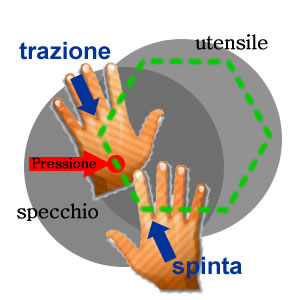DESCRIPTION
The last chord is the excavation technique more aggressively and effectively towards our mirror. In fact it allows to remove a large amount of material in a shorter time compared to the other past.
On the other hand is a technique that does not allow to obtain a regular shape, It should be used therefore only in the initial stages of blanking and up to approximate a few tenths of mm, the desired depth.
The mirror, in the upper position relative to the tool and decentralized, It is made to slide on the part of the latter device, for a stroke length up to 1/2 the diameter. Some races are performed with a considerable pressure at the center of the mirror, with the palm of a hand that rests on the center of the mirror, while the other guides the pushing movement from the edge, after a partial rotation around the operator's work plan is executed and, consequently, a partial rotation of the mirror in the opposite direction.
The trajectory of the races can be thought of as the sides of an ideal hexagon drawn on the tool surface, traveled by the center of the mirror ( fig.1 ). It starts with some rides on the first side and then makes a rotation to bring the trajectory on the row side and so on until a complete rotation.
SETTINGS AND ENFORCEMENT OF THE PAST chordal
- Position: mirror above and the tool under.
- Pressure: Strong and located in the center
- excursion: device until 1/2 the diameter
- racing Number: from 5 until 10 before the change of position.
- times : circa 2 seconds between 'return stroke, Average time to dried 3 minutes.
- Path: the operator moves around the tool according to the sides of a hexagon( fig green line. 1) and at each change of position the mirror wheel ( 20-30 degrees) in the opposite direction
- Grane used: 60-80 gritt (silicon carbide)
- Effectiveness: remarkable
- Form produced: central depression on the mirror, reduction of the thickness at the edge of the tool.
- Precautions: for use with a poor mixture of water.